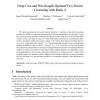Free Online Productivity Tools
i2Speak
i2Symbol
i2OCR
iTex2Img
iWeb2Print
iWeb2Shot
i2Type
iPdf2Split
iPdf2Merge
i2Bopomofo
i2Arabic
i2Style
i2Image
i2PDF
iLatex2Rtf
Sci2ools
SIAMDM
2010
2010
Drop Cost and Wavelength Optimal Two-Period Grooming with Ratio 4
We study grooming for two-period optical networks, a variation of the traffic grooming problem for WDM ring networks introduced by Colbourn, Quattrocchi, and Syrotiuk. In the two-period grooming problem, during the first period of time, there is all-to-all uniform traffic among n nodes, each request using 1/C of the bandwidth; and during the second period, there is all-to-all uniform traffic only among a subset V of v nodes, each request now being allowed to use 1/C of the bandwidth, where C < C. We determine the minimum drop cost (minimum number of ADMs) for any n, v and C = 4 and C ∈ {1, 2, 3}. To do this, we use tools of graph decompositions. Indeed the two-period grooming problem corresponds to minimizing the total number of vertices in a partition of the edges of the complete graph Kn into subgraphs, where each subgraph has at most C edges and where furthermore it contains at most C edges of the complete graph on v specified vertices. Subject to the condition that the two-...
| Added | 30 Jan 2011 |
| Updated | 30 Jan 2011 |
| Type | Journal |
| Year | 2010 |
| Where | SIAMDM |
| Authors | Jean-Claude Bermond, Charles J. Colbourn, Lucia Gionfriddo, Gaetano Quattrocchi, Ignasi Sau |
Comments (0)

